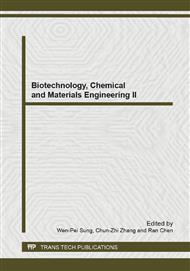[1]
D. Ye, B. Chen and Z. He: Journal of Anhui Agricultural Science Vol. 39, no. 7 (2011), pp.3811-3814. (in Chinese).
Google Scholar
[2]
M. C. Dinamarca,J. P. Sagal,R. A. Quintanilla,J. A. Godoy, M.S. Arrázola and N. C. Inestrosa: Molecular Neurodegeneration Vol. 5(2010), pp.4-15.
DOI: 10.1186/1750-1326-5-4
Google Scholar
[3]
J. J. Nair, A. O. Aremu, J. van Staden: Journal of Ethnopharmacology Vol. 137(2011), p.1102–1106.
Google Scholar
[4]
Z. Yang, J. Ren, P. Xue, M. Yang: Chinese Journal of Experimental Traditional Medical Formulae Vol. 17, no. 6(2011), pp.194-196. (in Chinese).
Google Scholar
[5]
Y. Ding , S. Yan , R. Xie and B. Huang: Chinese Journal of Tropical Agriculture Vol.31, no. 6(2011), pp.21-23. (in Chinese).
Google Scholar
[6]
G. M. Chuiko: Comparative Biochemistry and Physiology Part C Vol.127, no.3(2000), pp.233-242.
Google Scholar
[7]
Y. Zhao: Theory and Practice of Biochemical Techniques. (Wuhan University Press, Wuhan in China 1994). pp.287-321. (in Chinese).
Google Scholar
[8]
H. Zhang, Z. Xing and M. Sun: Military Medical Sciences,no. 6( 1983), pp.689-692. (in Chinese).
Google Scholar
[9]
S. Qu, S. He, Y. Huangfu, P. Jiang and S. Luo: Chinese Journal of Biochemistry and Molecular Biology Vol. 1, no. 4(1985), pp.29-35. (in Chinese).
Google Scholar
[10]
S. Li and D. Fan: China Environmental Science Vol. 17, no. 2(1997), pp.163-165. (in Chinese).
Google Scholar
[11]
M. J. Karnovsky and L. Roots: Journal of Histochemistry and Cytochemistry Vol. 12(1964), pp.219-221.
Google Scholar
[12]
A. EL-Badawi and E. A. Schenk: The Journal of Histochemical and Cytochemistry Vol. 15, no. 10(1967), pp.580-588.
Google Scholar
[13]
G. Zhao , S. Zhang,X. Huang,F. Zhan and A. He: Progress in Biochemistry and Biophysics Vol. 27, no. 4(2000), pp.438-439. (in Chinese).
Google Scholar
[14]
G. Zhao , S. Zhang, W. Lin, H. Huang, F. Zhan and A. He: Acta Agriculturae Universitatis Jiangxiensi Vol. 22, no. 4(2000), pp.589-590. (in Chinese).
Google Scholar
[15]
G. Zhao,F. Qian, B. Ling and Y. Cao: Journal of Shanghai Jiaotong University (Agricultural Science) Vol. 21, no. Suppl. (2003), pp.87-90. (in Chinese).
Google Scholar
[16]
P. Juul: Clinica Chimica Acta Vol. 19, no. 2(1968), pp.205-213.
Google Scholar
[17]
D. Wang,S. Wang, C. Li and X. Wang: Railway Occupational Safety Health and Environmental Protection, no. 4(1983), pp.62-65. (in Chinese).
Google Scholar
[18]
D. Chen; D. Shen: Journal of Chongqing Medical University Vol. 12, no. 4(1987), pp.230-234. (in Chinese).
Google Scholar
[19]
D. Yao, R. Ni, J. Huang and X. Meng: Medical Journal of Communications Vol. 5, no. 1(1991), pp.53-55. (in Chinese).
Google Scholar
[20]
Y. Liu, Y. Li , T. Fu and Q. Zhang: Progress in Veterinary Medicine Vol. 26, no. 7(2005), pp.53-56. (in Chinese).
Google Scholar


